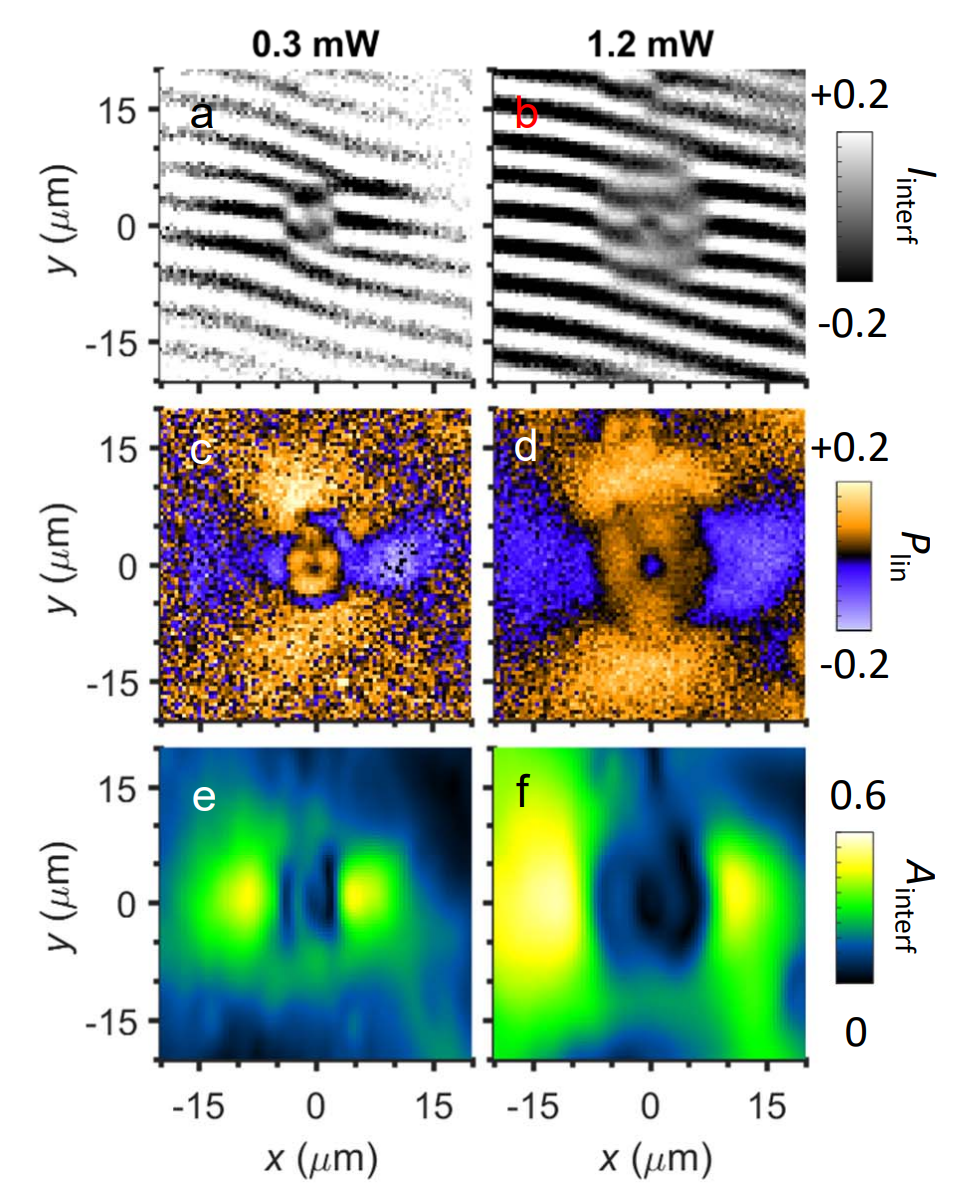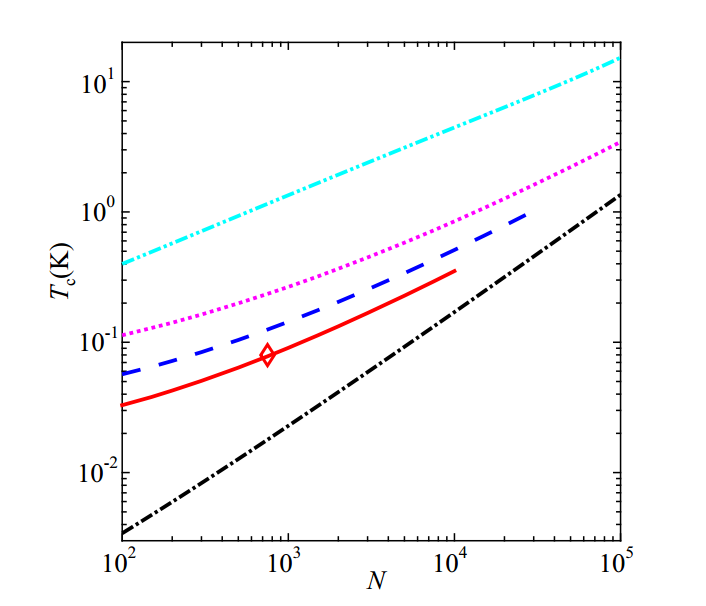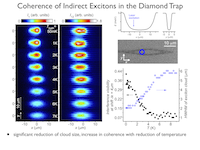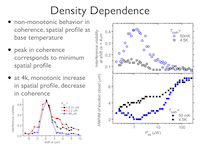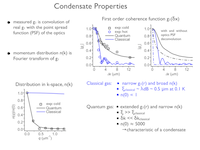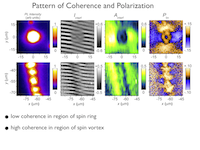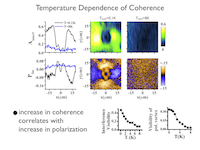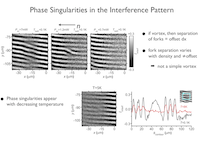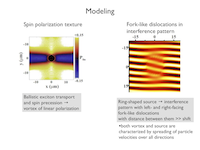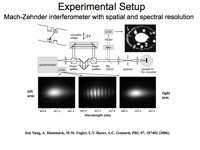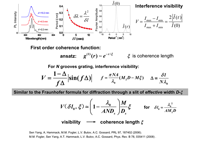Moiré pattern of interference dislocations in condensate of indirect excitons |
|
Interference patterns provide direct measurement of coherent propagation of matter waves in quantum systems. Superfluidity in Bose–Einstein condensates of excitons can enable long-range ballistic exciton propagation and can lead to emerging long-scale interference patterns. Indirect excitons (IXs) are formed by electrons and holes in separated layers. The theory predicts that the reduced IX recombination enables IX superfluid propagation over macroscopic distances. Here, we present dislocation-like phase singularities in interference patterns produced by condensate of IXs. We analyze how exciton vortices and skyrmions should appear in the interference experiments and show that the observed interference dislocations are not associated with these phase defects. We show that the observed interference dislocations originate from the moiré effect in combined interference patterns of propagating condensate matter waves. The interference dislocations are formed by the IX matter waves ballistically propagating over macroscopic distances. The long-range ballistic IX propagation is the evidence for IX condensate superfluidity. J.R. Leonard, Lunhui Hu, A.A. High, A.T. Hammack, Congjun Wu, L.V. Butov, K.L. Campman, A.C. Gossard,. Moiré pattern of interference dislocations in condensate of indirect excitons, Nature Commun. 12, 1175 (2021). |
|
Pancharatnam-Berry phase in condensate of indirect excitons |
|
We report on the observation of the Pancharatnam-Berry phase in a condensate of indirect excitons (IXs) in a GaAs coupled quantum well structure. The Pancharatnam-Berry phase leads to phase shifts of interference fringes in IX interference patterns. Correlations are found between the phase shifts, polarization pattern of IX emission, and onset of IX spontaneous coherence. The Pancharatnam-Berry phase is acquired due to coherent spin precession in IX condensate. The effect of the Pancharatnam-Berry phase on the IX phase pattern is described in terms of an associated momentum. J.R. Leonard, A.A. High, A.T. Hammack, M.M. Fogler, L.V. Butov, K.L. Campman, A.C. Gossard. Pancharatnam-Berry phase in condensate of indirect excitons, arXiv:1709.00533 (2017), Nature Commun. 9, 2158 (2018). |
|
Condensation in traps |
|
We present theoretical studies of condensation of indirect excitons in a trap. Our model quantifies the effect of screening of the trap potential by indirect excitons on exciton condensation. The theoretical studies are applied to a system of indirect excitons in a GaAs/AlGaAs coupled quantum well structure in a diamond-shaped electrostatic trap where exciton condensation was studied in earlier experiments. The estimated condensation temperature of the indirect excitons in the trap reaches hundreds of milliKelvin. S.V. Lobanov, N.A. Gippius, L.V. Butov. Theory of condensation of indirect excitons in a trap, arXiv:1609.00357 (2016). |
|
Spontaneous coherence of indirect excitons in a trap |
|
We report on the emergence of spontaneous coherence in a gas of indirect excitons in an
electrostatic trap. At low temperatures, the exciton coherence length becomes much larger
than the thermal de Broglie wavelength and reaches the size of the exciton cloud in the trap.
A.A. High, J.R. Leonard, M. Remeika, L.V. Butov, M. Hanson, A.C. Gossard, Condensation of excitons in a trap, arXiv:1110.1337v2 (2011), Nano Lett. 12 (5), 2605-2609 (2012). A.A. High, J.R. Leonard, M. Remeika, L.V. Butov, M. Hanson, A.C. Gossard, Condensation of Excitons in a Trap, CLEO/QELS, May 7-11, 2012, San Jose, CA. |
|
Spontaneous coherence in a cold exciton gas |
|
Excitons, bound pairs of electrons and holes, form a model system to explore the quantum
physics of cold bosons in solids. Cold exciton gases can be realized in a system of indirect
excitons, which can cool down below the temperature of quantum degeneracy due to their long
lifetimes. Here, we report on the measurement of spontaneous coherence in a gas of indirect
excitons. We found that extended spontaneous coherence of excitons emerges in the region of
the macroscopically ordered exciton state and in the region of vortices of linear polarization.
The coherence length in these regions is much larger than in a classical gas, indicating a
coherent state with a much narrower than classical exciton distribution in momentum space,
characteristic of a condensate. We also observed phase singularities in the coherent exciton
gas. Extended spontaneous coherence and phase singularities emerge when the exciton gas is
cooled below a few Kelvin.
A.A. High, J.R. Leonard, A.T. Hammack, M.M. Fogler, L.V. Butov, A.V. Kavokin, K.L. Campman, A.C. Gossard, Spontaneous Coherence in a Cold Exciton Gas, arXiv:1109.0253v2 (2011), Nature 483, 584 (2012). A.A. High, J.R. Leonard, A.T. Hammack, Sen Yang, M.M. Fogler, L.V. Butov, T. Ostatnicky, M.R. Vladimirova, A.V. Kavokin, K.L. Campman, A.C. Gossard, Spontaneous Coherence in a Cold Exciton Gas, Spin Currents in a Coherent Exciton Gas, CLEO/QELS, May 7-11, 2012, San Jose, CA. |
|
Effect of spatial resolution on the estimates of the coherence length |
|
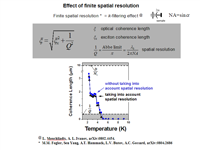
|
We evaluate the effect of diffraction-limited resolution of the optical system on the estimates of the coherence length of two-dimensional excitons deduced from the interferometric study of the exciton emission. The results are applied for refining our earlier estimates of the coherence length of a cold gas of indirect excitons in coupled quantum wells. We show that the apparent coherence length is well approximated by the quadratic sum of the actual exciton coherence length and the diffraction correction given by the conventional Abbe limit divided by π. In practice, accounting for diffraction is necessary only when the coherence length is smaller than about one wavelength. The earlier conclusions regarding the strong enhancement of the exciton coherence length at low temperatures remain intact. M.M. Fogler, Sen Yang, A.T. Hammack, L.V. Butov, and A.C. Gossard, Effect of spatial resolution on the estimates of the coherence length of excitons in quantum wells, arXiv:0804.2686v2 (2008); Phys. Rev. B 78, 035411 (2008). |
Coherence Length of Cold Exciton Gases in Coupled Quantum Wells |
|
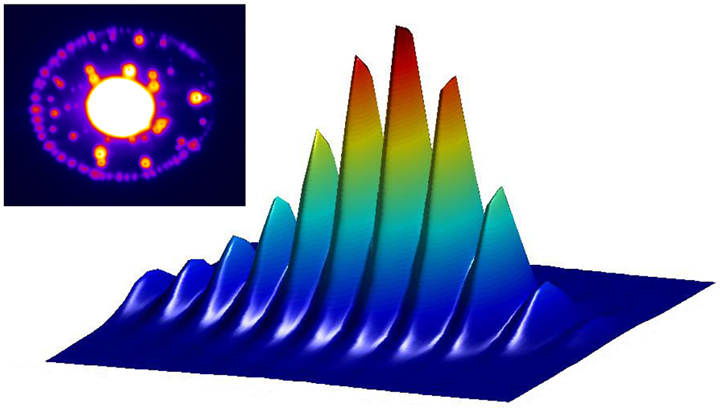
|
A Mach-Zehnder interferometer with spatial and spectral resolution was used to probe spontaneous coherence in cold exciton gases, which are implemented experimentally in the ring of indirect excitons in coupled quantum wells. A strong enhancement of the exciton coherence length is observed at temperatures below a few Kelvin. The increase of the coherence length is correlated with the macroscopic spatial ordering of excitons. The coherence length at the lowest temperature corresponds to a very narrow spread of the exciton momentum distribution, much smaller than that for a classical exciton gas. Sen Yang, A.T. Hammack, M.M. Fogler, L.V. Butov, and A.C. Gossard, Coherence length of cold exciton gases in coupled quantum wells, cond-mat/0606683 (2006); Phys. Rev. Lett. 97, 187402 (2006). |



